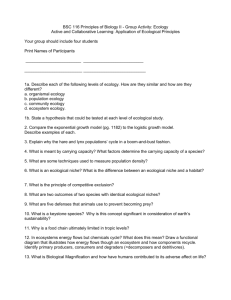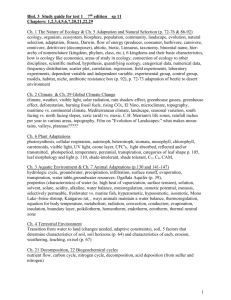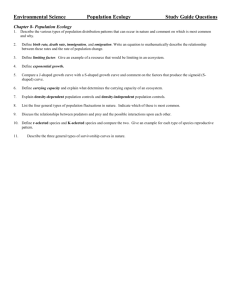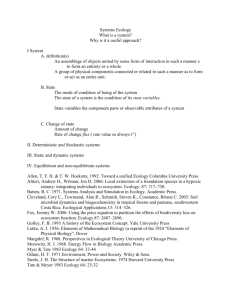Ecology
advertisement
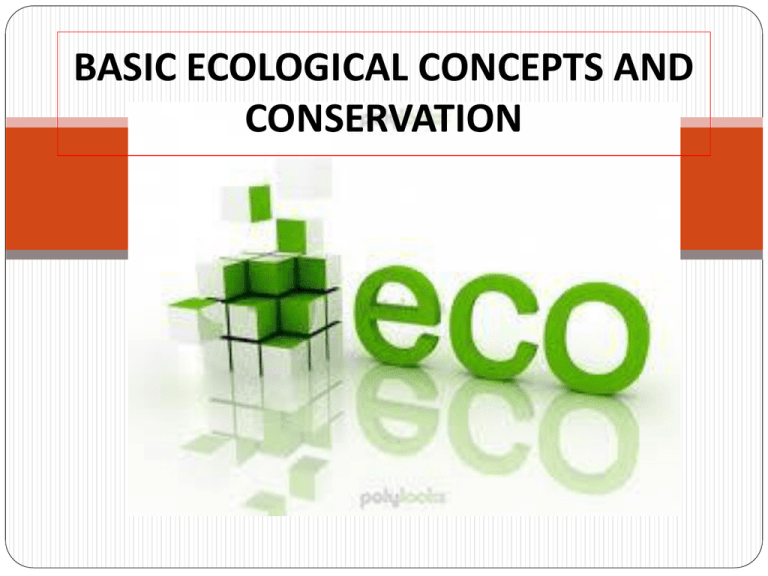
BASIC ECOLOGICAL CONCEPTS AND
CONSERVATION
People often use the terms ecology and environment as if
they meant the same thing. Students, homeowners,
politicians, planners, and union leaders speak of
"environmental issues" and "ecological concerns.
However, scientists use the terms ecology and
environment in a more restricted way.
Ecology is the branch of biology that studies relationships
between organisms and their environments. This is a very
simple definition for a very complex branch of science.
Environment has a very different meaning. Most ecologists
define the word environment very broadly as anything that
affects an organism during its lifetime. These environmental
influences can be divided into two broad categories: biotic
environmental factors and abiotic environmental factors.
Definitions,
Concepts and
Principles
Ecology is the study of how organisms interact with one another and
with their physical and chemical environment (Reiss and Chapman, 2000;
Dickinson and Murphy, 1998).
The economic of nature (Haeckel, 1928)
Economic: The study of how and why individuals or groups make
decision about the use and distribution of valuable resources (Field, 2006).
Sounds similar with
Politic
Concept: a general idea that is created by abstracting, drawing
away, or removing the uncommon characteristic or
characteristics of several particular ideas.
Major concepts
Pool of resources and
condition
Various degree of
utilization/exploitation
Interconnection among various
profession
Group of individual
performing particular
exploitation activities
Individual-independent actor
Concepts: Organism
Behavior: refers to the actions of a system or
organism, usually in relation to its environment.
Adaptability: adaptability in the field of
organizational management can generally be seen as
an ability to change something or oneself to fit to
occurring changes. In ecology, adaptability has been
described as the ability to cope with unexpected
disturbances in the environment
Many other physiological concepts
Concepts: Population
Growth
Decrease
Structure of performance (age, sex,
survivorship, etc.)
Limiting factors
Concepts: Community
Diversity &
Composition
Dominance
Energy flows
Features/Life form
Diversity of job & occupation
Social structure
Production, Distribution and
Consumption
Social characteristics
Concepts: Ecosystem
Interface between the
activities and
environment
A complexes of people’s activities in
managing natural resources
Principles:
Principles are generally true
statements, can be referred to as or base
on laws or theories (Bunce, 1993).
Principle can be regarded as
proposition among variables or
dimensions
Principles in
Ecology:
Ecological Principles are generally
true statements, can be referred to as or
base on laws or theories (Bunce, 1993).
Ecological Principle can be
regarded as ecological proposition among
variables or dimensions in ecology
Principles in
Ecology:
Carrying capacity
Every ecosystem has limits in terms of the size of various
populations that it can support.
Every species has certain needs that the community must
provide in order for it to survive and continue to exist
(Reiss and Chapman, 2000).
Total demand on resources = population x
average demand per individual
Carrying capacity
Carrying capacity refers to the number of individuals that can
be supported in a given area within natural resource limits, and
without degrading the natural social, cultural and economic
environment for present and future generations.
The carrying capacity for any given area is not fixed. It can be
altered by improved technology, but mostly it is changed for the
worse by pressures which accompany a population increase.
Carrying capacity
The carrying capacity of a biological species in
an environment is the population size of the
species that the environment can sustain
indefinitely, given the food, habitat, water and
other necessities available in the environment. In
population biology, carrying capacity is defined as
the environment's maximal load
Principles in
Ecology:
Limiting Factors
In the natural world, limiting factors (i.e. the availability of
food, water, shelter and space) can affect the populations of
animals and plants (Hanks, 1996). In fact, a species may have a
wide range of tolerance for one factor but a narrow range of
tolerance for another. For example, species of: Terrestrial
Ecosystems- limiting factors are temperature, water, light,
nutrients, etc. Aquatic Ecosystems - limiting factors are
salinity, temperature, sunlight, dissolved oxygen, nutrients,
Principles in
Ecology:
Scientific laws with ecological relevance:
Example 1: The first & second law of
thermodynamics (Jones, 1997) 1st law,
energy can neither be created nor destroyed; it
can only be changed from one form into
another. 2nd law there is no loss of total
energy, but there is a loss of useful energy
Principles in
Ecology:
Diversity-Stability
One
rationale
for
maintaining biodiversity is
a presumed relationship
between the number of
species in a community
and the stability of the
community.
Elton’s 6 reasons
1. simple models fluctuate more than complex
models
2. the more pathways available for energy to reach
a consumer, the less severe the consequences of
losing one pathway (redundancy)
3. agricultural monocultures more prone to pest
outbreaks than mixed communities
4. pest outbreaks rare in tropical ecosystems (more
diverse than temperate)
5. population cycles occur primarily in speciespoor ecosystems (arctic regions)
6. invasion by new species is easiest in oceanic
islands that are species-poor
Principles in
Ecology:
Stability – A system is stable if and only if the variables
all return to initial equilibrium state after a perturbation
(Pimm 1986) {a mathematical definition of stability} 4
components:
Resilience – speed of return to equilibrium
Persistence – the time a variable lasts before
changing to a new value
Resistance – how large a disturbance is needed to
perturb system
Variability – the normal range of values at
equilibrium
Principles in
Ecology:
Productivity
Gross Primary Productivity (GPP) is the rate at which an
ecosystem's producers capture and store chemical energy as
biomass. Net Primary Productivity (NPP) is GPP minus the rate
at which producers use stored chemical energy in their biomass.
This is the basic food source for all consumers. It is estimated that
humans waste 27% of the world's NPP (Jones, 1997).
Principles in
Ecology:
Population growth
Population is the function of times
Population growth is determined
by many circumstances , mainly
the availability of resources.
Sustainable in term of resources
availability is a key factor
determining the population
outbreak.
Population Growth
among pessimists
The pessimistic viewpoint on population growth is that they
think that a population which has a high growth rate will put a
strain on resources. They believe that there will not be enough
resources to be able to supply the large population.
Negative consequences of population growth on:
Economic growth
Poverty and Inequality
Education
Health
Food
Environment
International migration
Population growth in
the eye of Malthus
In 1798, Thomas Malthus published An Essay on the Principle of Population, describing
his theory of quantitative development of human populations:
“ I think I may fairly make two postulata. First, that food is necessary to the existence
of man. Secondly, that the passion between the sexes is necessary and will remain
nearly in its present state. These two laws, ever since we have had any knowledge of
mankind, appear to have been fixed laws of our nature, and, as we have not hitherto
seen any alteration in them, we have no right to conclude that they will ever cease to
be what they now are, without an immediate act of power in that Being who first
arranged the system of the universe, and for the advantage of his creatures, still
executes, according to fixed laws, all its various operations. ...
Assuming then my postulata as granted, I say, that the power of population is
indefinitely greater than the power in the earth to produce subsistence for man.
Population, when unchecked, increases in a geometrical ratio.
—Malthus 1798, Chapter 1
Population growth in
the eye of Malthus
Thomas Malthus' Theory
of Population that was
proposed more than two
centuries ago, foretold the
problems of food shortage
that the world is facing
today, due to uncontrolled
increase in population.
Although not foolproof,
the theory influenced the
formulation of Darwin's
Theory of Natural
Selection.
Review towards
Malthus’ theory
Thomas Malthus based his theory on the population explosion that was already
becoming evident in the 18th century, and argued that the number of people
would increase faster than the food supply. Population would eventually reach a
resource limit (overpopulation), and any further increase would result in a
population crash, caused by famine, disease, or war.
Malthus was not optimistic about the outcome and suggested that only ‘moral
restraint’ (birth control) could prevent crisis. More recently, famines in Ethiopia
and other countries, where drought, civil war, and poverty have reduced
agricultural output, might suggest that he was correct. In the USA, the UK, and
other developed countries, the agrarian revolution boosted food production, and
contraception led to a decline in birth rate; and in some countries, such as China,
population control policies have been introduced.
Review towards
Malthus’ theory
Ester Böserup wrote in her book The Conditions of Agricultural Growth:The Economics of
Agrarian Change under Population Pressure, that population levels determine agricultural
methods, rather than agricultural methods determining population (via food supply). A
major point of her book is that "necessity is the mother of invention".
Julian Simon was one of many economists who challenged the Malthusian catastrophe,
citing (1) the existence of new knowledge, and educated people to take advantage of it,
and (2) "economic freedom", that is, the ability of the world to increase production
when there is a profitable opportunity to do so.
The economist Henry George argued that Malthus didn't provide any evidence of a
natural tendency for a population to overwhelm its ability to provide for itself. George
wrote that even the main body of Malthus' work refuted this theory; that examples given
show social causes for misery, such as "ignorance and greed... bad government, unjust
laws, or war," rather than insufficient food production.
Garret Hardyn’s
Theory
"The Tragedy of the Commons," written by Garrett Hardin and first
published in the journal Science in 1968.
The tragedy of the commons can be considered in relation to environmental
issues such as sustainability. The commons dilemma stands as a model for a
great variety of resource problems in society today, such as water, land, fish,
and non-renewable energy sources such as oil and coal.
The tragedy of the commons is a dilemma arising from the situation in
which multiple individuals, acting independently and rationally consulting
their own self-interest, will ultimately deplete a shared limited resource
even when it is clear that it is not in anyone's long-term interest for this to
happen.
Garret Hardyn’s
Theory
At the beginning of his essay, Hardin draws attention to problems that cannot
be solved by technical means, i.e., as distinct from those with solutions that
require "a change only in the techniques of the natural science, demanding
little or nothing in the way of change in human values or ideas of morality".
Hardin contends that this class of problems includes many of those raised by
human population growth and the use of the Earth's natural resources.
To make the case for "no technical solutions," Hardin notes the limits placed
on the availability of energy (and material resources) on earth, and also the
consequences of these limits for “quality of life" To maximize population, one
needs to minimize resources spent on anything other than simple survival,
and vice versa. Consequently, he concludes that there is no foreseeable
technical solution to increasing both human populations and their standard of
living on a finite planet.
Debate
Pessimists vs optimists
For some time there has been an ongoing
conflict between environmental pessimists such
as Paul Ehrlich and Norman Myers and
environmental optimists such as Julian Simon
and Boserup. The conflict is characterized by
extremely divergent views on the existence and
significance of many, mainly global,
environmental problems.
Population Growth
among optimists
Population is not the problem but the following
are:
Population distribution
Underdevelopment
Resource depletion and environmental
degradation
Subordination of women
Population Growth
among optimists
Optimists believe that the 2006 population level of over
six billion may be supported by current resources, or that
the global population may grow to ten billion and still be
within the Earths carrying capacity.
The falling rates of population growth in some parts of the
world and, (the population decrease in some parts ?) and
because the rapid innovation of science and technologies,
there is little problem with overpopulation. Optimists
claim that there will be no mass starvation due to a
shortage of arable land.
Population growth an
its implication
Population growth an
its implication
What is the earth’s carrying capacity for the human
population? The answers to this question have ranged
from a low of 500,000 to a high of tens of billions
[Cohen – p 402-418]. Most of these estimates are little
more than ideologically driven guesses. The question
cannot be answered without considering consumption
levels, and the technologies used to generate the
consumption.
Population growth an
its implication
The Ecological Footprint data (see Measuring Scale:
Ecological Footprint) suggest that 3 – 4 planets with the
earth’s bio-productive capacity would be required to
support the current population at the consumption level
of North Americans. Even more productive land would
be required to support a growing population that
consumes at this level. This is clearly a physical
impossibility with current technologies. Either
technologies must increase resource productivity by
more than a factor of four, or consumption levels must
decline, or population must decline.
Ecological Footprint
AMONG THE OPTIMISTS, SOME NOTIFICATIONS of THE
APPLICATION OF SCIENCES & TECHNOLOGIES;
Sciences and technologies
(the soft components of
development)for better future
There are four aspects of its
application towards
sustainable planet
4 aspects that should be covered by the
Sciences and Technologies’ Application
Environmental Aspects. One important point of
view of not be worsening the environment toward
the sustainability of the developmental projects.
Organizational aspects. Related with the
professionalism and management.
Technical aspects. Related with the development of
skills, techniques and tools.
Cultural aspects. The application of sciences and
technologies should be based on the cultural of its
society (rural and urban).
1. The act of conserving; prevention of injury, decay, waste, or loss;
preservation: conservation of wildlife; conservation of human rights.
2. Official supervision of rivers, forests, and other natural resources in order
to preserve and protect them through prudent management.
3. A district, river, forest, etc., under such supervision.
4. The careful utilization of a natural resource in order to prevent depletion.
Conservation biology is the scientific study of the nature and status of
Earth’s biodiversity with the aim of protecting species, their habitats and
ecosystem from excessive rates of extinction. It is an interdisciplinary
subject drawing on sciences, economics, and the practice of natural
resources management.
1.
Conserving and managing representative examples of ecosystem
2.
Maintaining essential ecological processes and variety of nature through.
3.
Conserving biological diversity at all level
4.
Practicing recycling, reusing and reducing consumable goods and products and selecting
environmentally friendly products
5.
Respecting traditional knowledge in managing natural resources
6.
Building attitude towards a good institutional ecology


